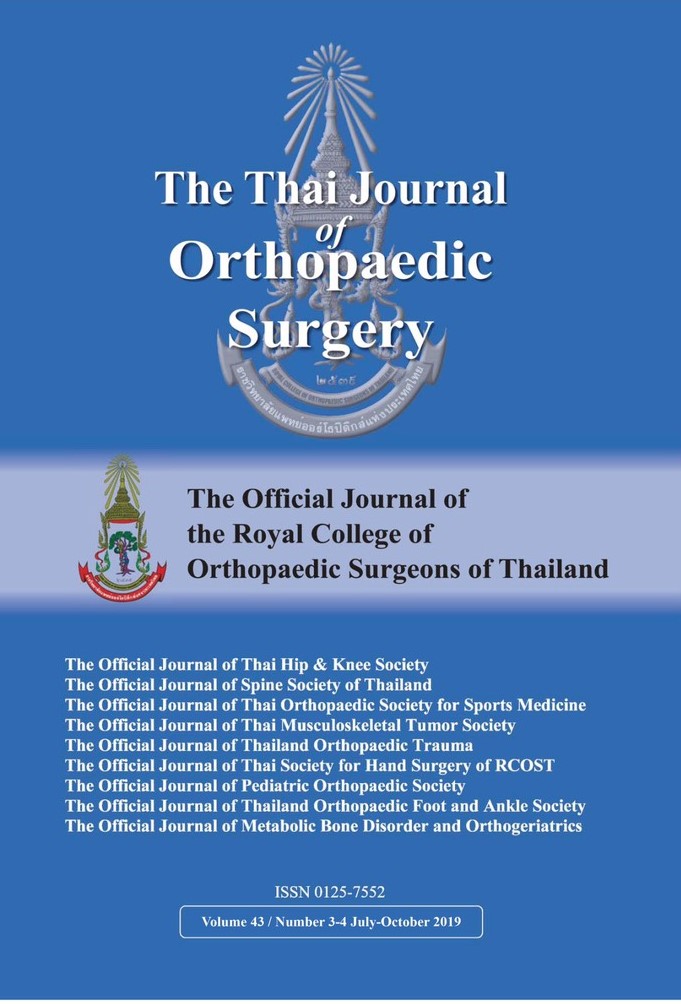Enhanced Stability of Kirschner Wire Fixation for Articular Fractures of Distal Humerus with Locked Kirschner Wire Fixation: A Finite Element Analysis
Main Article Content
Abstract
Purpose: Condylar fractures of distal humerus with or without comminution are difficult to restore and stabilize. Some fracture configurations may not be firmly stabilized by standard plate fixation only. Such conditions, K-wire fixation may be helpful for supplement fixation to fix the articular fragment beyond the area of the plate and screw that can be covered. However, using traditional straight K-wire fixation has been reported with poor outcome. The aim of this study is to evaluate the biomechanical behavior of “locked K-wire fixation” mode – the extraosseous part of K-wire is bended and the bent portion is fixed underneath a small plate and screw – compare with traditional straight K-wire for fixation of condylar fractures of distal humerus.
Methods: The 3D model of unicondylar and bicondylar fractures of distal humerus was simulated with type 13-B1, 13-B2 and combined 13-B1+ 13-B2 AO classification intra-condylar fracture based on computed tomography (CT) data. The fixation configuration was created into locked K-wire fixation mode. The stability of fixation method and the von Mises stress were analyzed using finite element analysis (FEA) compared with traditional straight K-wire fixation model. Four loading situation simulated in this study, which were 250 N axial force, 10 N.m bending torsion around frontal, 10 N.m valgus torsion around sagittal axis and 7.5 N.m internal rotation torsion around the longitude axis.
Result: Locked K-wire fixation mode provides better stability and lower von Mises stress than straight K-wire fixation in unicondylar fractures in both 13-B1 and 13-B2 AO fracture types. For bicondylar fractures (13-B1+13-B2), locked K-wire fixation using 2-K-wire with bent portion at lateral side provide better stability and lower von Mises stress of K-wire than traditional 2 straight K-wires fixation in almost all loading test. Locked K-wire using 2 K-wire and bent portion at medial side provide better outcome in only axial compression and valgus rotation tests. Using combine 2 locked K-wire with bent portion at medial side and another 2 at lateral side provide better stability and lower von Mises stress than 4 straight K-wire fixation in all testing conditions.
Conclusion: Locked K-wire fixation provide better stability than traditional straight K-wire fixation for condylar fracture both for unilateral and bilateral condylar fractures of distal humerus. The method will be benefit in case that the articular fragment cannot be covered by the plate fixation system that need supplement K-wire fixation for unstable condylar fragments.
Article Details
References
2. Jost B, Adams RA, Morrey BF. Management of acute distal humeral fractures in patients with rheumatoid arthritis. A case series. J Bone Joint Surg Am. 2008; 90(10): 2197-205.
3. Jung SW, Kang SH, Jeong M, Lim HS. Triangular Fixation Technique for Bicolumn Restoration in Treatment of Distal Humerus Intercondylar Fracture. Clin Orthop Surg. 2016; 8(1): 9-18.
4. Nauth A, McKee MD, Ristevski B, Hall J, Schemitsch EH. Distal humeral fractures in adults. J Bone Joint Surg Am. 2011; 93(7): 686-700.
5. Aktan C, Ertan MB, Turan A, Kose O. Fixation of Small Osteochondral Fragments in a Comminuted Distal Humerus Fracture with Magnesium Bioabsorbable Screws: A Case Report. Cureus. 2018; 10(12): e3752.
6. Kamrani RS, Mehrpour SR, Aghamirsalim MR, Sorbi R, Zargar Bashi R, Kaya A. Pin and plate fixation in complex distal humerus fractures: surgical technique and results. Int Orthop. 2012; 36(4): 839-44.
7. Mendoza-Muñoz I, González-Ángeles A, Siqueiros-Hernández M, Montoya-Reyes M. Biomechanical principles used in finite element analysis for proximal humeral fractures with locking plates. Med Sci Tech. 2017; 58: 128-36.
8. Chantarapanich N, Sitthiseripratip K, Mahaisavariya B, Siribodhi P. Biomechanical performance of retrograde nail for supracondylar fractures stabilization. Med Biol Eng Comput. 2016; 54(6): 939-52.
9. Wei L, Ling M, An Z. Biomechanical analysis of a novel plating for intra-articular distal humerus fractures: combined anteromedial and anterolateral plating. J Orthop Surg Res. 2019; 14(1): 132.
10. Yang KH, Park HW, Park SJ, Jung SH. Lateral J-plate fixation in comminuted intercondylar fracture of the humerus. Arch Orthop Trauma Surg. 2003; 123(5): 234-8.
11. Reising K, Hauschild O, Strohm PC, Suedkamp NP. Stabilisation of articular fractures of the distal humerus: early experience with a novel perpendicular plate system. Injury. 2009; 40(6): 611-7.
12. Stoffel K, Cunneen S, Morgan R, Nicholls R, Stachowiak G. Comparative stability of perpendicular versus parallel double-locking plating systems in osteoporotic comminuted distal humerus fractures. J Orthop Res. 2008; 26(6): 778-84.
13. Penzkofer R, Hungerer S, Wipf F, von Oldenburg G, Augat P. Anatomical plate configuration affects mechanical performance in distal humerus fractures. Clin Biomech (Bristol, Avon). 2010; 25(10): 972-8.
14. Got C, Shuck J, Biercevicz A, Paller D, Mulcahey M, Zimmermann M, Blaine T, Green A. Biomechanical comparison of parallel versus 90-90 plating of bicolumn distal humerus fractures with intra-articular comminution. J Hand Surg Am. 2012; 37(12): 2512-8.
15. Kudo T, Hara A, Iwase H, Ichihara S, Nagao M, Maruyama Y, Kaneko K. Biomechanical properties of orthogonal plate configuration versus parallel plate configuration using the same locking plate system for intra-articular distal humeral fractures under radial or ulnar column axial load. Injury. 2016; 47(10): 2071-6.
16. Kamrani RS, Oriadi LZ. Treatment of humerus supracondylar nonunion with pin and plate fixation as a simple device. Chirugie de la main 2015; 34(6): 332.


